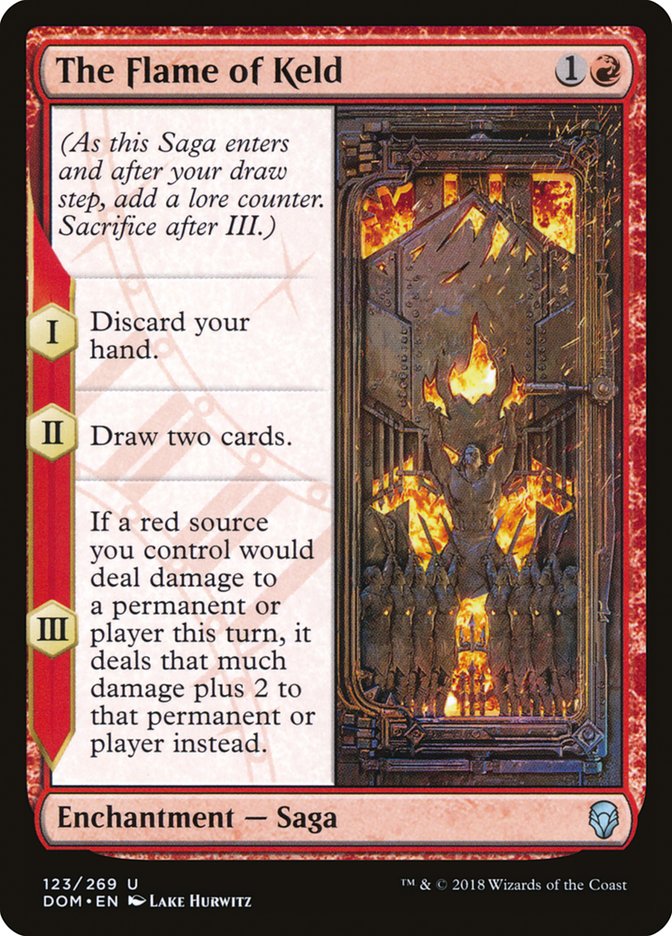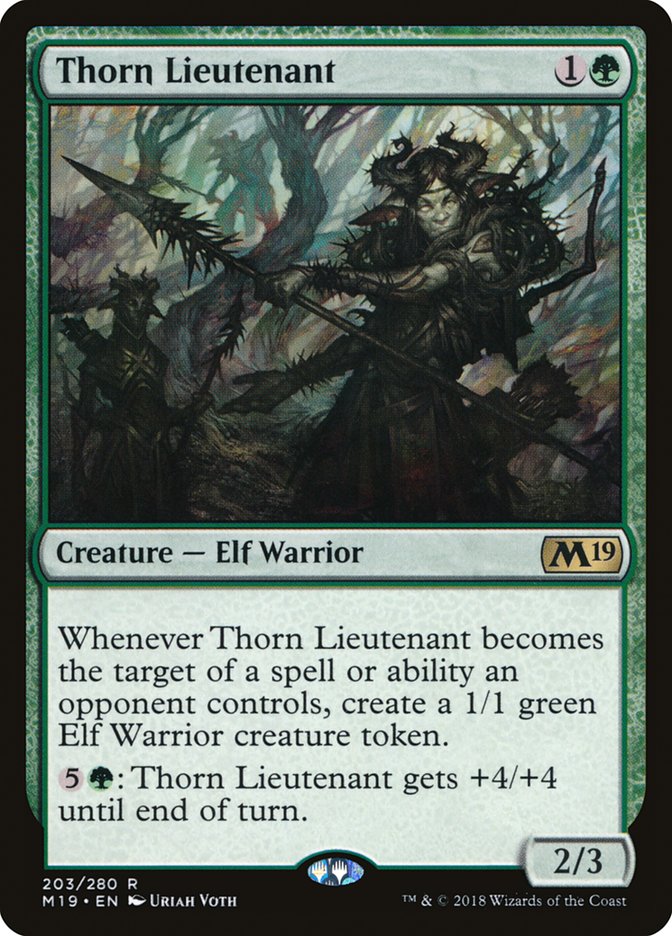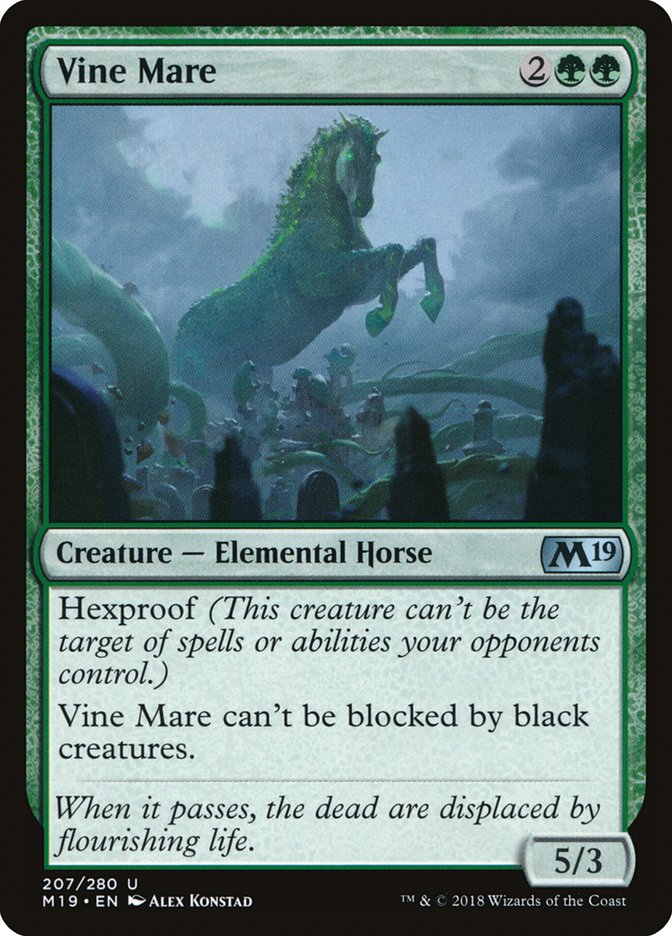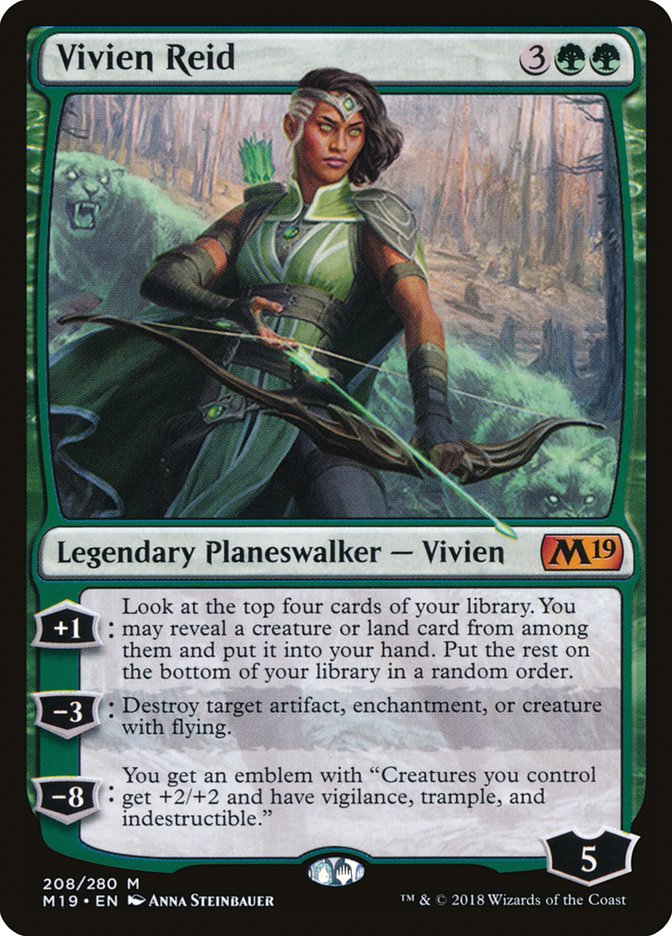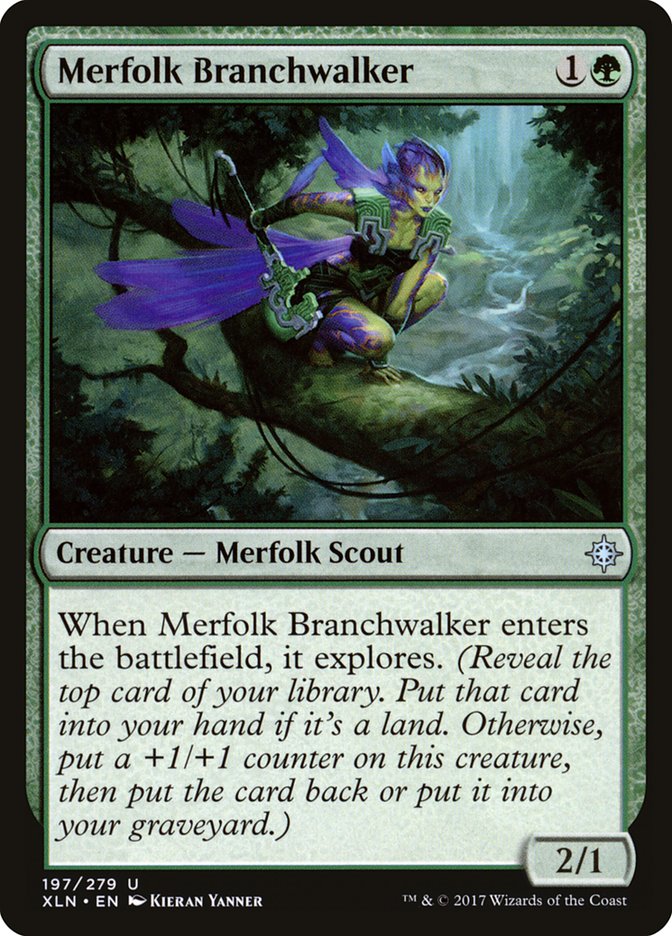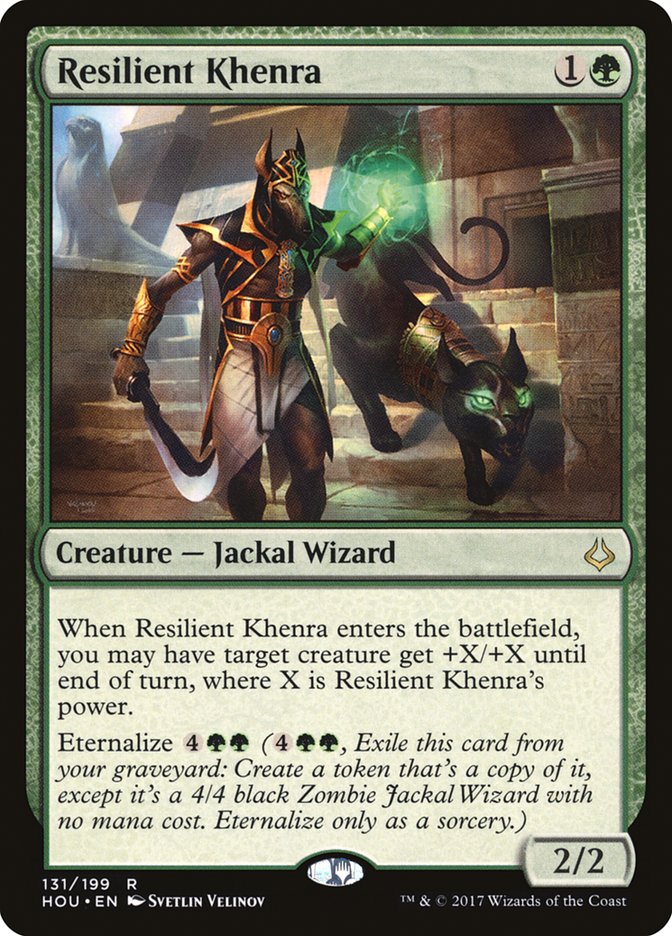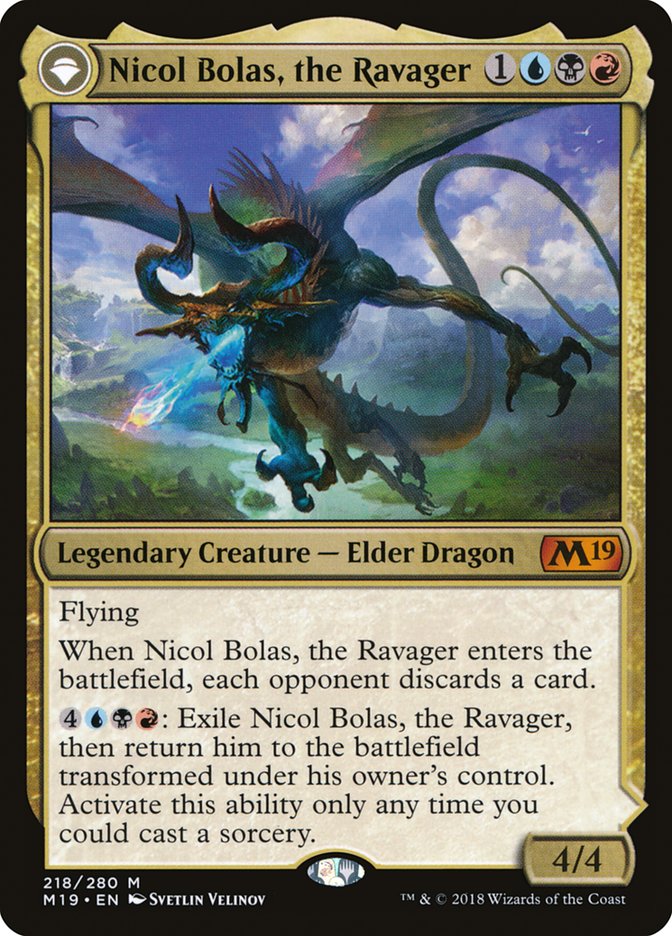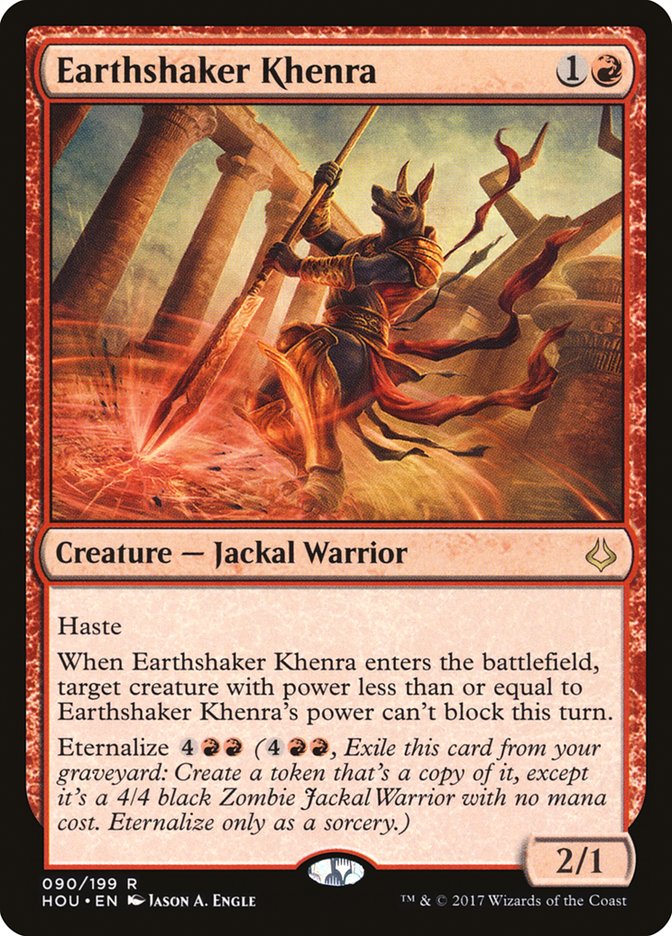Red mages have had it good for a while in Standard. Ever since Wyatt
Darby’s win at Pro Tour Dominaria, the Standard narrative has been
all about the Goblin of the hour:
For a while there, I think the entire Magic community was collectively sick
of hearing about how good Goblin Chainwhirler was. Well, everyone except
the red players. The neat thing about those few months of red’s dominance
though was just how many different red decks were in the
spotlight. You could go big, you could go small, you could even add a
second color to your deck and still consistently cast your triple colored
three-drop. The available options were truly an embarrassment of riches for
the masses of loyal red players out there.
But times have changed. The effects of the introduction of Core Set 2019 on this Standard format are still a little murky and
likely will be until after Pro Tour 25th Anniversary, but one outcome is
beginning to make itself known: red has gotten worse. Change is the nature
of Standard, and this is a sad one for fans of basic Mountain.
These last two weekends I’ve had the pleasure of teaming with
Aaron Barich
for #SCGWOR and #SCGPHILLY.
Despite Aaron’s well-known Infect prowess, we chose to have Aaron play red
decks in Standard for both tournaments for one simple reason: he is incredible with them. His win rate in red mirrors over those two
weekends was astounding. On the other hand, I had an excellent seat to
watch the unveiling of red’s decline as unfortunately, those red mirrors
were a solid 70% of his overall wins. Red got worse, we were too slow to
adapt, and our results paid the price.
Not that Red Aggro is dead, by any means. The deck has still put up results
over the last two weekends, even if those results are less impressive than
they once were. It’s very clear to me that something tangible has changed,
and the first step to getting red back on top will be understanding what
that something is.
Understanding the Variants
But before we can dive in to the new problems afflicting our beloved
Mountains, we need to be sure we have a good grasp on the fundamental
differences between the builds. We’ll start at the top of the food chain
and take a brief look at R/B Aggro:
Creatures (23)
- 1 Pia Nalaar
- 4 Bomat Courier
- 4 Scrapheap Scrounger
- 2 Kari Zev, Skyship Raider
- 2 Glorybringer
- 2 Hazoret the Fervent
- 2 Soul-Scar Mage
- 2 Rekindling Phoenix
- 4 Goblin Chainwhirler
Planeswalkers (2)
Lands (25)
Spells (10)

I say ‘top of the food chain’ because R/B Aggro is, by and large, the
biggest of the Red Aggro variants, and I say ‘brief look’ because
Owen Turtenwald
has already said everything I could want to say about the deck, and much
more besides. From his
third place
finish with the deck at Pro Tour Dominaria to
mulligan exercises
and
finer points
, Owen has written a lot of excellent words on the archetype, and
you’re doing yourself a huge disservice if you’re even considering picking
the deck up without reading all of them first.
For our purposes going forward, here’s what you should keep in mind about
the deck:
-
The biggest red deck, generally playing 25 land and eight cards
costing four or more mana. -
Decreased reliance on Hazoret the Fervent, often only playing two
or three copies. -
Plays Scrapheap Scrounger and Heart of Kiran over classic red one
and two-drops like Soul-Scar Mage and Earthshaker Khenra. -
Access to black mana grants better removal in the form of
Unlicensed Disintegration and better sideboard options in the form
of Duress, Doomfall, and Hour of Glory.
Next up, let’s look at what I’ll refer to as “classic” Mono-Red Aggro:
Creatures (26)
- 3 Bomat Courier
- 2 Kari Zev, Skyship Raider
- 4 Hazoret the Fervent
- 2 Ahn-Crop Crasher
- 4 Soul-Scar Mage
- 4 Earthshaker Khenra
- 3 Rekindling Phoenix
- 4 Goblin Chainwhirler
Lands (24)
- 24 Mountain
Spells (10)

There’s something aesthetically appealing about that manabase. 24
mountains, no messing around. Indeed, that cleanness is one of the big
draws to this variant: no manabase-induced stumbling. You never have to
mulligan because you don’t have a sufficient quantity of untapped lands in
your opening hand, you never rip the fourth land you need for Hazoret only
for it to be a Canyon Slough, you never have to stare at a basic Swamp that
can’t cast a Goblin Chainwhirler no matter how hard it tries.
Here’s the abridged version of the important features of this build:
-
Smaller than R/B Aggro, but not by much. 24 land and seven spells
that cost four or more, exactly one less of each than R/B Aggro
plays. -
The full four copies of Hazoret, typically eschewing Glorybringer
and Chandra, Torch of Defiance in the main. -
More copies of the cheap red creatures, especially Earthshaker
Khenra. -
Forced to play Fight with Fire in the sideboard to answer Lyra
Dawnbringer and other troublesome creatures due to lack of better
options.
Last and least, at least in terms of size, are the small red decks. Sitting
next to Aaron Barich for two weekends in a row, I got to see plenty of this
deck in action. Here’s the list he played at #SCGWOR:
Creatures (26)
- 4 Bomat Courier
- 2 Kari Zev, Skyship Raider
- 4 Hazoret the Fervent
- 2 Ahn-Crop Crasher
- 4 Soul-Scar Mage
- 2 Earthshaker Khenra
- 4 Ghitu Lavarunner
- 4 Goblin Chainwhirler
Lands (22)
- 22 Mountain
Spells (12)

There’s actually a couple different ways to build a small red deck right
now in Standard. The fundamental idea behind all of them is that you’re
going to play less lands, less expensive spells, and more reach. Your plan
is to overwhelm the opposition early with cheap creatures, then burn them
out after they stabilize. There’s multiple ways to accomplish these goals:
Aaron favors a version of this deck that avoids going down the path of The
Flame of Keld, instead just enjoying a full eight spells that deal three to
the face with a light sprinkling of Ghitu Lavarunner to turn your Wizard’s
Lightning into Lightning Bolt a high enough percentage of the time. The
Flame of Keld versions do the same thing, but to make The Flame of Keld
something worth writing home about they must give up Hazoret, something
Aaron has been unwilling to do.
Here’s what you need to know:
-
The smallest red deck, playing only 21 or 22 lands and at most four
pay-off spells, either Hazoret or The Flame of Keld. -
More reach than any other red deck; all the maindeck removal spells
can be pointed at the opponent’s face. -
Will typically have a sideboard plan that lets it go a bit bigger
to beat opponents ready for you to curve out, but unable to beat a
Chandra, Torch of Defiance or a Vance’s Blasting Cannons in a long
game. -
Far more reliant than any other version of red on getting in early
attacks with its plethora of cheap creatures; its early offense
being stymied usually spells disaster.
Understanding the Problems
Alright, with all of that in mind it’s time to discuss the new problems
facing the Red Aggro decks. First up:
Creatures (30)
- 4 Llanowar Elves
- 4 Scrapheap Scrounger
- 3 Greenbelt Rampager
- 3 Rhonas the Indomitable
- 3 Ghalta, Primal Hunger
- 2 Thrashing Brontodon
- 4 Steel Leaf Champion
- 3 Vine Mare
- 4 Thorn Lieutenant
Lands (24)
Spells (6)

The rise of Mono-Green Aggro in Core Set 2019 Standard has been a
huge problem for the red decks. Before Core Set 2019, the matchup
was likely slightly favored for Mono-Green Aggro, but it was close enough
that you didn’t have to be too upset about playing against Forests
when you chose to wield Mountains. Even better, the deck wasn’t very widely
played, meaning that this one bad matchup for Red Aggro just didn’t matter
very much. Now, things have changed:
These are the three Core Set 2019 cards that
Andrew Jessup
identified as the game-changers for Mono-Green Aggro in his
article
about figuring out new Standard, and time has proven him right. Mono-Green
Aggro is absolutely a real deck now, and that’s a real problem for Red
Aggro. Myself, I think Vine Mare is the biggest contributor to Mono-Green’s
recent success, giving it easy wins against the black midrange
decks it used to struggle with. It’s not often a single card can upend a
matchup so completely, but Vine Mare sure manages it.
But Vine Mare isn’t the new card that the red decks care the most about.
That honor belongs to Thorn Lieutenant. Take a look at the cards Mono-Green
was playing before the printing of Thorn Lieutenant:
From the perspective of Red Aggro, do you know what the biggest difference
between these cards and Thorn Lieutenant is? If you answered the triggered
ability, I disagree. You aren’t wrong about the triggered ability on Thorn
Lieutenant being a huge beating, but it’s the third point of toughness on
the card that makes the ability even matter.
The cheap red creatures are not good at attacking into three toughness
blockers. The normal plan when presented with them is to clear the way with
a burn spell, but Mono-Green Aggro just absolutely overloads the red
player’s removal with troublesome blockers. When Mono-Green Aggro had some
anemic bodies like Merfolk Branchwalker and Resilient Khenra, sometimes you
could forge a path. With those cards being replaced with a two-drop that
blocks all the early creatures, the early aggression plan of red can
basically be thrown completely out the door in this matchup. If the matchup
was close before Core Set 2019, it’s not anymore.
This means that the impact of Core Set 2019 with regards to
Mono-Green’s impact on Red Aggro is two-fold: not only did the bad matchup
that is Mono-Green Aggro get better and therefore more popular, it got
better in a way that makes the matchup considerably worse than it was. This
is a double hit to Red Aggro and does a lot to explain the downswing it’s
on.
Moving on from Mono-Green, and indeed, from mono-colored cards as a whole,
I have to talk about one more Core Set 2019 card that’s hurting
Red Aggro in a big way:
On its face, Nicol Bolas, the Ravager doesn’t look like a card
that Red Aggro should care very much about. It’s a four-drop after all, and
one that doesn’t impact the battlefield in anyway outside of being a 4/4 at
that. Turn 4 is about when the red decks are preparing to switch from early
aggression to closing the game with Hazoret or burn spells anyway, so why
does Nicol Bolas matter?
Well, what you must keep in mind is that it’s not just about Nicol Bolas,
it’s about how Nicol Bolas changed his archetype. Before there was Grixis
Midrange, there was B/U midrange. Take a look at this pre- Core Set 2019 list:
Creatures (15)
Planeswalkers (1)
Lands (26)
Spells (18)

And now, take a look at the deck that won the #SCGPHILLY
Standard Classic:
Creatures (17)
- 1 Torrential Gearhulk
- 3 Whirler Virtuoso
- 4 Glint-Sleeve Siphoner
- 3 The Scarab God
- 3 Champion of Wits
- 3 Nicol Bolas, the Ravager
Planeswalkers (1)
Lands (26)
Spells (17)

Grixis Midrange is the clear successor to the B/U Midrange deck. It uses
the same Champion of Wits engine and is still very much a The Scarab God
deck. In terms of overall strategy and even quantity of removal spells and
threats, B/U Midrange and Grixis Midrange have the same shell. A stock list
of Grixis Midrange has yet to emerge, but here’s the highlights of the ways
its differences from B/U Midrange is trending:
-
The removal spells are proactive rather than reactive, with Grixis
decks erring on the side of Harnessed Lightning rather than Essence
Scatter -
Ability to end the game significantly faster, with the curve of its
significant threats now starting at four with Nicol Bolas the
Ravager rather than at five with The Scarab God, and a slightly
more creature-dense build. -
A deeper embracing of the energy subtheme with some adoption of
both Harnessed Lightning and Whirler Virtuoso. -
A more complicated and less consistent manabase, as you would
expect from the addition of a third color.
The last bullet point is good news for Red Aggro decks, but that’s all the
good news you’ll find in that list. B/U Midrange didn’t want more versatile
removal spells badly enough to warrant adding red mana for them, but if
it’s in the red mana market anyway it will gladly take them. Essence
Scatter was a clean answer to Hazoret and Rekindling Phoenix, but it was an
answer that red decks could often punish the B/U decks for playing.
Counterspells provide counter play in a way Doom Blade never does, and the
red decks were very adept at making the most of their counter play
potential.
The value of the simple fact that Nicol Bolas gives the Grixis Midrange
deck the ability to turn the corner on Red Aggro much faster than B/U
Midrange was ever able to cannot be overstated. The speed at which a deck
can shift to the offensive is always an important part of beating
aggressive decks with any amount of reach, as no matter how secure your
position on the battlefield, given enough time the aggressive deck will
find what it needs to deal the last few points. Previously, B/U Midrange
relied on The Scarab God to turn the corner, and games where you never saw
a copy were very hard to win in a timely fashion. Nicol Bolas effectively
doubles the number of cards you can rely on to start your opponent’s clock
ticking.
As for Nicol Bolas itself in roles other than ending the game, well, the
news isn’t good there either. Four toughness is a great number to have
against the Red Aggro decks, and since the transform ability on the card is
mostly flavor text in the matchup, the Grixis players don’t really mind
trading their Nicol Bolas for a Heart of Kiran or risking it to a
post-combat Goblin Chainwhirler if they need to in order to stabilize. It’s
yet another card from Core Set 2019 that makes the format much
better at effectively blocking the red creatures than it used to be.
Further, the discard effect stapled onto Nicol Bolas is surprisingly
effective in the matchup. Sure, sometimes it enables Hazoret a turn earlier
than the red player would have otherwise managed, but that doesn’t come up
that often. And yes, the Red Aggro decks are incentivized to empty their
hands thanks to Hazoret and will likely not have a card to discard to a
Nicol Bolas that comes down significantly off-curve, but that’s just
evidence of why the discard is so good: Red Aggro intends to use all its cards to secure the twenty points of damage it needs. When
red wants to use all its cards, even losing the worst one it has left can
be a big deal.
So, in summary: Red Aggro is worse in new Standard because the great cards
from Core Set 2019 are significantly better against Red Aggro than
the cards they are replacing. Collectively, they make the early aggression
plan of Red Aggro less viable against multiple decks in the metagame, and
their power level works to increase the metagame share of those decks.
Making Sense of the Results
All of this lends itself to the following conclusion:
Small Red Aggro variants are no longer a viable archetype.
Sorry, Aaron. The trend in the format is towards the early aggression of
red no longer being impressive, and the smaller red variants are the ones
that relied on them the most heavily. If you’re looking to play red any
time soon, I would leave your Wizard’s Lightnings and your The Flame of
Kelds at home.
Not that the other red variants have escaped unscathed from this shift in
the format. Every version of red enjoys the early pressure that they can
consistently unleash, and the effectiveness of that onslaught being reduced
is certainly a blow to their win rate. But the bigger versions weren’t as
dependent on that early creature rush and thus, aren’t being hit as hard.
To me, the biggest takeaway here is that Earthshaker Khenra is on its way
out. A 2/1 is just not at all where you want to be in this new Standard. It
can’t attack into nearly any Mono-Green battlefield and can’t
threaten a post-combat Goblin Chainwhirler to take down a Nicol Bolas, the
Ravager. The third point of power is very valuable right now. For
all the same reasons, I also am not really looking to register Ghitu
Lavarunner either.
Creatures (27)
- 4 Bomat Courier
- 4 Scrapheap Scrounger
- 3 Kari Zev, Skyship Raider
- 4 Hazoret the Fervent
- 2 Ahn-Crop Crasher
- 4 Soul-Scar Mage
- 2 Rekindling Phoenix
- 4 Goblin Chainwhirler
Lands (24)
Spells (9)

This is the third-place list from the #SCGPHILLY
Standard Classic. Note how it eschews Earthshaker Khenra for Scrapheap
Scrounger, with the lightest touch of black sources in the list to enable
Scrounger’s activated ability. This is the Mono-Red deck of the future,
with every creature in it that costs two or more comfortable attacking into
a four-toughness blocker.
As for R/B Aggro, the deck is still extremely playable in its previous
incarnation. While the shifts in the format are hurting it too, it wasn’t
playing any cards in the Earthshaker Khenra vein that got absurdly worse in
the new format. The ease at which it can incorporate creatures with flying
is particularly attractive to me, and I wouldn’t be at all surprised to see
an increase in the Heart of Kiran, Glorybringer, and Rekindling Phoenix
numbers in these lists is the format goes on.
Still, I wouldn’t say that I’m happy with where R/B Aggro is right
now. The deck can still win and will likely be the best choice at various
points of time as the metagame shifts, but it looks unlikely to once again
become the undisputed best deck of the format unless radical changes are
made. To that end, I’ve heard rumors that
Matt Severa
will be writing about a Grixis take on Red Aggro later this week, so make
sure to check that out if you’re interested in the potential future of red.
I know I sure will.




